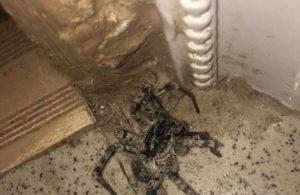Mizgir spider: steppe earthen tarantula
One of the most interesting spiders is the South Russian tarantula or mizgir, as it is popularly called. It can be found in many regions of the Russian Federation and European countries. Often a spider in the name gets a prefix depending on the locality: Ukrainian, Tatar, etc.
Content
South Russian tarantula: photo
Description of the South Russian tarantula
Name: South Russian tarantula
Latin: Lycosa singoriensisClass: Arachnida - Arachnida
Squad: Spiders - Araneae
Family: Wolves - Lycosidae
 | Habitats: | dry steppes, fields |
 | Dangerous for: | insects and small arachnids |
 | Attitude towards people: | do not harm, but bite painfully |
The tarantula spider is a poisonous arthropod that is best avoided. The body of the misgir consists of a cephalothorax and a larger belly. There are 4 pairs of eyes on the cephalothorax. Vision allows you to see objects almost 360 degrees and covers a distance of about 30 cm.
This color of the South Russian tarantula is a kind of "camouflage". It goes well with the landscape, so it is often inconspicuous even in open areas. There are arachnoid warts on the abdomen. They secrete a thick liquid, which, when solidified, becomes a strong web.
Sex difference
Females reach 3,2 cm, and males - 2,7 cm. The weight of the largest female is 90 gr. Compared to males, females are more stocky due to the fact that the abdomen is larger and the legs are shorter.
The South Russian tarantula is divided into races:
- small, which lives in the southern steppes;
- large, only in Central Asia;
- intermediate, ubiquitous.
Life
South Russian tarantulas have a solitary lifestyle. They only tolerate other spiders when they mate. The males are constantly fighting.
Each female has its own mink up to 50 cm deep, built as deep as possible. All walls are woven with cobwebs, and the entrance to the hole is sealed with cobwebs. During the day, the mizgir is in a hole and watches everything that happens above. Insects get into the web and become prey.
Life cycle
The life span of a mizgir in nature is 3 years. By winter, they hibernate. The mating season begins at the end of August. Males make special movements along the web, attracting females. With consent, the female makes similar movements, and the male descends into the hole. After the process is completed, the male must immediately run away so as not to become the prey of the female.
In the spring, eggs are laid in a special cocoon of cobwebs. Eggs for one laying, there are from 200 to 700 pieces. From one pair can get up to 50 individuals with one mating.
- The female with a cocoon sits on the edge of the mink with her belly up so that the future offspring can be in the sun.
- In the first time after hatching, the cubs are on the belly, and the female takes care of them.
- She travels and even overcomes the water, gradually shedding her children, thereby spreading the offspring.
- To the state of an adult spider, the cubs undergo the molting procedure 11 times.
Habitat
Places of minks - rural and suburban areas, hills, fields. He is often a neighbor of people, representing a danger. The depth of planting potatoes is equal to the depth of the mink. Collecting culture, you can stumble upon the shelter of an arthropod.
Mizgir prefers desert, semi-desert and steppe climate. This species is distributed over a wide area. Favorite regions:
- Asia Minor and Central Asia;
- south of Russia;
- Ukraine;
- south of Belarus;
- Far East;
- Turkey.
Mizgir diet
Spiders are real hunters. At the slightest movement and fluctuation of the cobweb, they jump and catch prey, injecting poison and paralyzing. Mizgir eats:
- grasshoppers;
- beetles;
- cockroaches;
- caterpillars;
- bears;
- slugs;
- ground beetles;
- small lizards.
Mizgir's natural enemies
Of the natural enemies, it is worth noting the road wasps (pompilides), the Samara anoplia, and the ringed cryptochol. Eggs of South Russian tarantulas are exterminated by riders. Young individuals should be wary of a bear.
Misgir bite
The spider is not aggressive and the first does not attack. Its venom is not fatal to humans, but dangerous to small animals. The bite can be compared to the bite of a hornet. Symptoms include:
- swelling, burning;
- the presence of 2 punctures;
- redness;
- pain sensations;
- in some cases, fever;
- yellowed skin in the affected area (the shade may persist for 2 months).
The bite of the South Russian tarantula is dangerous only for a person prone to allergic reactions. A person develops a rash, blisters, vomiting, a very high temperature rises, the heart rate quickens, limbs go numb. In such cases, immediately call an ambulance.
First aid for a bite of mizgir
A few tips for disinfecting the wound and restoring the skin:
- wash the bite site with soap and water;
- treated with any antiseptic. Suitable hydrogen peroxide, alcohol, vodka;
- apply ice to relieve pain
- take antihistamines;
- apply an anti-inflammatory agent (for example, Levomycitin ointment);
- drink plenty of fluids to remove toxins from the body;
- the bite site is kept elevated.
Conclusion
Mizgir is included in the Red Book of several regions of Russia and Ukraine. Since 2019, for the first time, it has become part of the zoo in Prague. Some people even keep these arthropods as pets, as they are not aggressive and look unusual due to their hairline.
Previous

